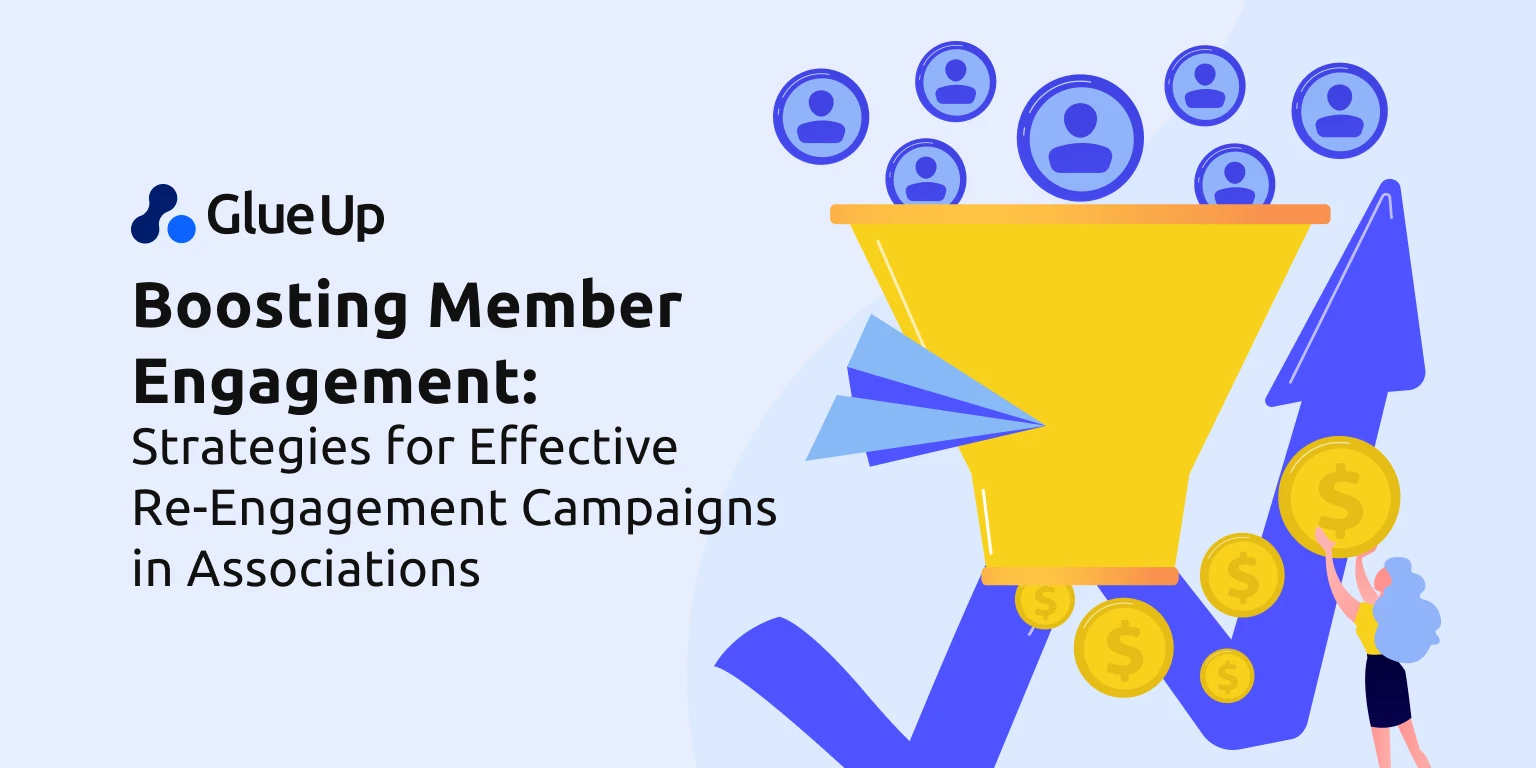
Engaged members are more likely to renew their membership, participate in events, and contribute to the overall success of your association. However, even the most committed members can become disengaged over time.
That's where reengagement campaigns come in.
In this blog post, we'll explore what re-engagement campaigns are, how to build an effective automated re-engagement email campaign, and share eight tips to win back inactive members.
Key Takeaways
- Re-engagement campaigns are targeted efforts to reconnect with members who have become inactive or disengaged, reminding them of the value the association provides and encouraging them to become active participants once again.
- Building an automated re-engagement email campaign involves identifying inactive members, segmenting the list, crafting targeted messaging, setting up automation, sending a series of emails, having a clear goal (reactivation or removal), and monitoring and adjusting the campaign based on results.
- Tips to win back inactive members include expressing concern about their lack of engagement, providing an easy path to resources, keeping messages short and sweet, focusing on members' interests, leveraging social proof, considering personalized outreach, sending association-wide e-blasts, and segmenting the association based on factors like membership level, industry, or location.
- Regularly cleaning the email list, offering incentives, continuously providing value, and engaging members before renewal time are additional strategies to maintain a healthy, engaged membership base.
- Integrating an AI-powered association management software (AMS) like Glue Up can automate and streamline re-engagement efforts, making it easier to identify inactive members, segment lists, deliver personalized content at scale, and analyze campaign performance to refine strategies and boost member engagement efficiently.
What is a Re-Engagement Campaign?
A re-engagement campaign is a targeted effort to reconnect with members who have become inactive or disengaged.
These campaigns are designed to remind members of the value your association provides and encourage them to become active participants once again.
Re-engagement campaigns can take many forms, including:
- Email campaigns
- Social media outreach, and
- Targeted advertising
How to Build an Automated Re-Engagement Email Campaign?
According to a study by the Annuitas Group, organizations that use marketing automation to nurture prospects experience a 451% increase in qualified leads (HubSpot Blog) (IMPACT).
Thus, an automated re-engagement email campaign is an effective way to reach out to inactive members and encourage them to re-engage with your association.
Here are the steps to building an effective one:
Step 1: Identify Inactive Members
Start by identifying members who haven't engaged with your association in a while. This could be based on criteria such as event attendance, email open rates, or website activity.
Glue Up's member management features make it easy to track member engagement and identify inactive members.
You can quickly generate reports on event attendance, email open rates, website activity, and more, giving you a clear picture of which members need a little extra attention.
Step 2: Segment your List
Once you've identified inactive members, segment your list based on factors such as membership level, interests, or past engagement. This will allow you to tailor your messaging to each group.
Step 3: Craft your Messaging
Your re-engagement emails should remind members of the value your association provides and encourage them to take action. Use a friendly, conversational tone and include a clear call to action.
Glue Up's email marketing tools include a range of templates and design options, making it easy to create professional-looking emails that capture your members' attention. You can also use Glue Up's merge fields and AI Copilot to personalize your messaging for each member, increasing the likelihood of engagement.
Step 4: Set up your Automation
Use an email marketing platform to set up your automated campaign. This will allow you to send targeted emails to each segment of your list based on their behavior and engagement level.
According to a study, businesses that use segmented campaigns note a 760% increase in revenue (Keap). Automation also helps improve click-through rates by 152% (OptinMonster). This makes it essential for efficient and effective email marketing.
Step 5: Send a Series of Re-Engagement Emails

Plan to send a series of emails to each segment, rather than just one message. Multiple touchpoints give inactive members more opportunities to re-engage.
Your email series could start with a "we miss you" message, follow up with a reminder of membership benefits, and end with a clear call-to-action or special offer.
6: Have a Clear Goal for Your Campaign - Reactivation or Removal
Your re-engagement campaign should aim to either get inactive contacts engaging with emails again or remove them from the list if they remain unresponsive. Having unengaged contacts hurts email deliverability and the sender's reputation.
Studies show that 20% of emails sent to inactive recipients never reach their inboxes when sent to unengaged contacts (OptinMonster) (Keap).
Be prepared to clean your list of chronically inactive members after giving them ample chance to re-engage.
Step 7: Monitor and Adjust
As your campaign runs, monitor the results and make adjustments as needed. Test different subject lines, messaging, and calls to action to see what resonates with your audience.
You can easily monitor your campaigns through Glue Up's analytics dashboard. It provides real-time data on your campaign's performance, allowing you to track key metrics like open rates, click-through rates, and conversions.
With this information at your fingertips, you can quickly identify what's working and what's not, and make data-driven decisions to optimize your campaign for maximum impact.
Don't Lose Them! 13 Tips to Win Back Inactive Association Members
Don’t Be Afraid to Express Your Concern about Their Lack of Engagement
Let your inactive members know that you've noticed their absence and that you value their participation. Use language that shows you care about their experience and want to help them re-engage.
Glue Up’s AMS has an advanced feature called Member Engagement Scorecards (MES) that allows you to easily identify inactive members and send targeted re-engagement campaigns.
Additionally, you can leverage Glue Up's powerful automation tools to create personalized emails that show your inactive members you value their participation and want to help them get the most out of their membership.
Provide an Easy Path to Resources

Make it easy for members to access the resources and benefits your association provides. Include links to your website, member portal, and other valuable resources in your re-engagement emails.
Glue Up's member portal provides a centralized hub for your members to access all the resources and benefits your association offers. By integrating your member portal with your re-engagement campaigns, you can provide inactive members with a seamless path back to engagement.
Keep it Short and Sweet
Your re-engagement emails should be concise and to the point. Use short paragraphs, bullet points, and clear calls to action to make your message easy to digest.
Keep the Members' Interests in Mind
Focus your messaging on the topics and issues that matter most to your members. Use data from past engagements and surveys to identify the areas where your members are most passionate and tailor your messaging accordingly.
Leverage Social Proof

Use social proof to remind members of the value your association provides. Share testimonials from engaged members, highlight successful events and initiatives and showcase the impact your association is making in your industry or community.
Consider Member Engagement Outreach
Consider reaching out to inactive members directly through personalized outreach from your membership team or admin staff. A personal touch can go a long way in making members feel valued and encouraging them to re-engage.
Send Association-Wide E-Blast
In addition to targeted re-engagement campaigns, consider sending association-wide e-blasts to remind all members of the value your association provides. Use these e-blasts to highlight upcoming events, share industry news and insights, and promote the benefits of membership.
Glue Up's email marketing tools allow you to easily create and send engaging e-blasts to your entire association. With customizable templates, drag-and-drop editing, and detailed analytics, Glue Up makes it easy to keep your members informed and engaged.
Segment Your Association
Finally, remember that not all members have the same needs and interests.
Segment your association based on factors such as membership level, industry, or geographic location, and tailor your messaging and benefits accordingly. This will help ensure that every member feels like they have a place in your association and are receiving value from their membership.
Glue Up's segmentation features allow you to easily divide your member base into targeted groups based on a wide range of criteria. By leveraging these segments in your re-engagement campaigns and ongoing communications, you can ensure that every member receives messaging and benefits that are tailored to their specific needs and interests.
Consider Your List Size and Overall Database Health
Take note of what percentage of your contacts are unengaged.
Having a high proportion of inactive members is costly and indicates an unhealthy database. In addition to re-engagement efforts, review how contacts are being added to your list in the first place. Ensure you're attracting quality leads and have strategies to keep members engaged from the start.
Regularly Clean your List

Periodically remove inactive members from your email list if they remain unresponsive after re-engagement attempts. This will keep your database lean, improve deliverability, and allow you to focus on active members.
Offer Incentives
To encourage inactive members to re-engage, consider offering special incentives or exclusive content. This could be a discount on event registration, access to a members-only resource, or a free trial of a premium service.
Continuously Provide Value
The best way to prevent members from becoming inactive in the first place is to consistently provide value through your communications, events, and resources. Regularly survey your members to understand their needs and preferences and use that feedback to shape your engagement strategies.
Connect Before Renewal Time
One of the most important times to engage with your members is before their membership renewal date.
Use your re-engagement campaigns to remind members of the value your association provides and encourage them to renew their membership. Consider offering incentives such as early bird discounts or bonus resources to encourage members to renew early.
In conclusion, re-engagement campaigns are a powerful tool for boosting member engagement and ensuring the long-term success of your association. By identifying inactive members, segmenting your list, crafting targeted messaging, and using the tips outlined above, you can win back inactive members and keep your association thriving for years to come.
However, executing effective re-engagement campaigns can be time-consuming and complex, especially for associations with limited resources. That's where you should consider integrating an association management software (AMS).
An AI-powered AMS like Glue Up can automate and streamline your re-engagement efforts, making it easier to identify inactive members, segment your list, and deliver personalized content at scale.
With Glue Up's AI-powered AMS, you can:
- Identify and segment inactive members based on their engagement history
- Create and send targeted re-engagement campaigns with just a few clicks
- Analyze campaign performance and member behavior to continuously refine your strategies
- Integrate with your existing tools and platforms for a seamless workflow
By leveraging the power of AI and automation, Glue Up's AMS empowers associations to efficiently and effectively re-engage inactive members, freeing up time and resources to focus on delivering value and growing the organization.
Ready to take your member engagement to the next level?
Sign up for a free demo of Glue Up's AI-powered association management software today. Our experts will show you how Glue Up can help you win back inactive members, boost engagement, and achieve your association's goals.
Remember, your members are the heart of your association, and investing in their engagement is an investment in your organization's future. With the right strategies and tools, you can keep your members active, engaged, and committed to your association's success.



